Japan
Wood Products Prices
Dollar Exchange Rates of 10th
Sep
2021
Japan Yen 109.29
Reports From Japan
Private sector urges government
to lift restrictions
The Japan Business Federation (Keidanren) has urged the
government to take action to restart economic and social
activities as the number of people vaccinated rises. Tokura
Masakazu, Keidanren Chairman, said the country needs
measures "to get the economy up and running again."
The private sector proposed shortening the
quarantine
period for people entering Japan to a maximum of 10 days
from 14 days currently which is under consideration.
The government is considering reducing the selfquarantine
period for vaccinated arrivals from overseas.
Currently everyone from overseas has to remain isolated
for 14 days. A 10 day quarantine is being considered
because social and economic activities must resume. The
new arrangement will apply to those inoculated with the
Pfizer, Moderna or AstraZeneca vaccines and could come
into effect at the end of September.
Dip in household spending
July household spending grew slower than expected as a
resurgence in COVID-19 cases undermined consumer
activity. The Japanese economy cannot shake off the
impact of the pandemic because the slow roll-out of
vaccinations means restrictions on movement must be
maintained. Household spending rose 0.7% year-on-year
in July after a 4% fall in June but the rise in July was
partly due to a sharp contraction in July last year.
See:
https://www.reuters.com/business/retail-consumer/japansjuly-household-spending-rises-less-than-expected-2021-09-07/
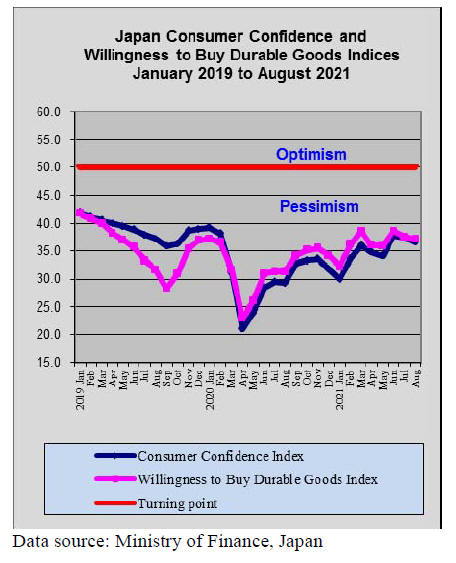
Yen/dollar exchange had short rocky ride
The US dollar/ yen exchange rate reacted to the decision
by Japan¡¯s Prime Minister, Yoshihide Suga, not to seek a
second term as prime Minister. His decision came at a
time when the Covid situation has worsened because of
the slow rollout of vaccines. The exchange rate volatility
was also impacted by recent economic data from the
United States. The US added just 235,000 jobs in August
while the unemployment rate dipped to 2.5%.
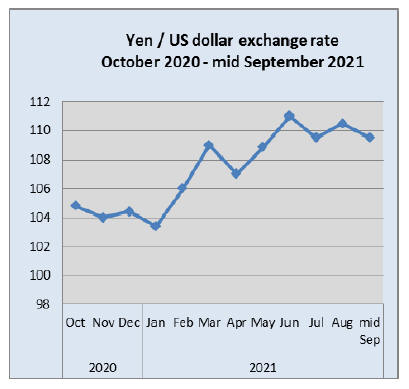
Forecast decline in housing starts
The Nomura Research Institute is forecasting a significant
drop in new housing starts across Japan by 2030.
According to the Institute¡¯s report housing starts are
forecast to drop from 950,000 units in 2018 to 730,000
units in 2025. In 2030, total housing starts are forecast to
be 630,000 units.
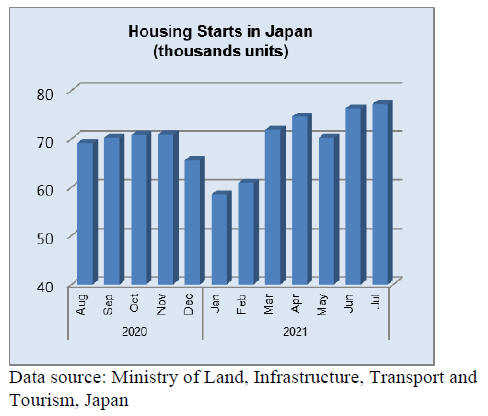
Import update
Wooden door Imports (HS441820)
China accounted for 56% of Japan¡¯s July 2021 imports of
wooden doors (HS441820) with a further 30% being
shipped to Japan from the Philippines. The only other
significant shipper in July was Indonesia which provided
an additional 6% of the total value of wooden door
imports in July.
Year on year, July 2021 imports were flat but there was a
4% decline in the value of July imports compared to June
of the same year.
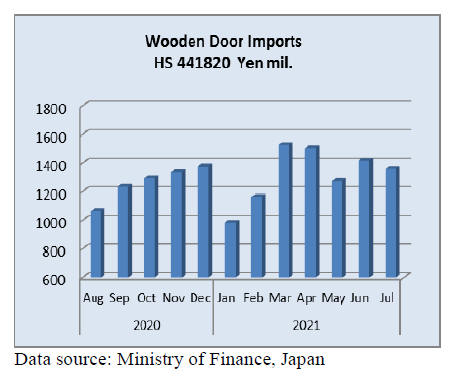
Wooden window imports (HS441810)
After peaking in May this year the value of Japan¡¯s
imports of wooden windows (HS441810) have fallen for
two consecutive months, dropping 5% month on month in
June and by 3% in July. As would be expected July 2021
imports were higher than in July 2020 but what is
significant is that the year on year rise was small.
Over 90% of Japan¡¯s imports of wooden windows came
from shippers in just three countries, China (47%), the US
(27%) and the Philippines (19%). Shippers in these three
countries dominate Japan¡¯s imports of wooden windows.
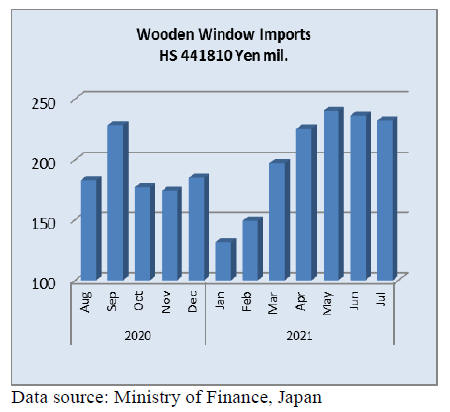
Assembled wooden flooring imports
After the steep rise in the value of assembled flooring
imports there was a correction in July. Compared to a
month earlier the value of assembled flooring imports in
July this year dropped 15%. Prior to the sharp rise in June
imports there had been three consecutive months where
the value of assembled flooring imports declined.
Year on year, the value of Japan¡¯s imports of assembled
wooden flooring (HS441871-79) in July rose 24%, but this
was from a low caused by various pandemic control
measures introduced by the Japanese government.
Imports of HS441875 acounted for most assembled
flooring imports with 45% being shipped from China.
Shippers in Vietnam continue to do well accounting for
22% of July 2021 imports.
The other major supplier was Indonesia which accounted
for 17% of the value of July 2021 imports.
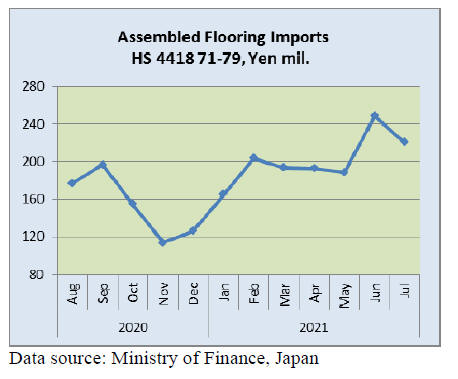
Plywood imports
While exhibiting marked swings the volume of plywood
imports during the first 7 months of 2021 has trended
higher. Import volumes are higher than in 2020 and July
2021 imort volumes were some 8% higher than in July
2019.
Year on year the volume of Japan¡¯s July imports of
plywood (HS441210-39) was up almost 40% and
compared to a month earlier the volume of plywood
imports rose almost 10%.
Of the four main shippers of plywood, Malaysia,
Indonesia China and Vietnam shipments from China rose
slightly in July compared to a month earlier, arrivals from
Malaysia also increased as they did from Vietnam but July
imports from Indonesia were at around the same level as
in June.
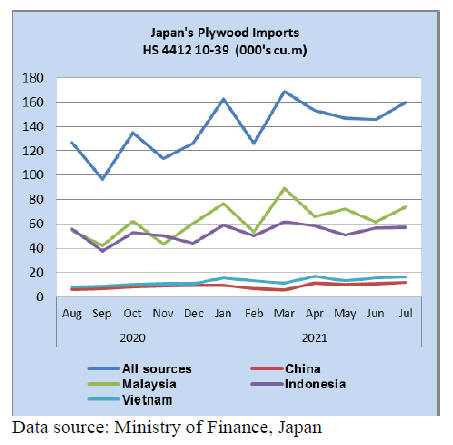
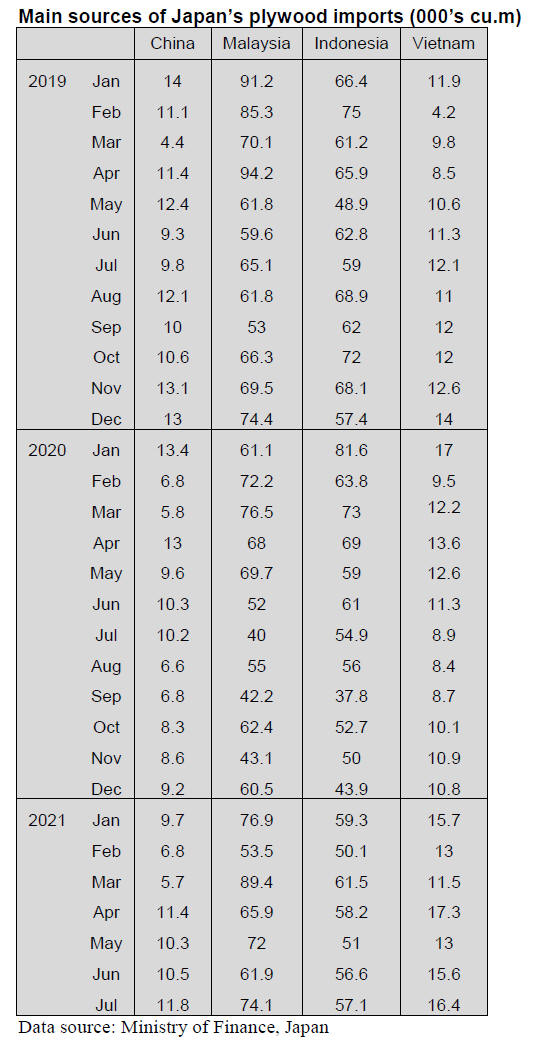
Trade news from the Japan Lumber Reports (JLR)
The Japan Lumber Reports (JLR), a subscription trade
journal published every two weeks in English, is
generously allowing the ITTO Tropical Timber Market
Report to reproduce news on the Japanese market
precisely as it appears in the JLR.
For the JLR report please see:
https://jfpj.jp/japan_lumber_reports/
Log demand for the first half of the year
Demand for logs in the first half of the year is 8,155,000
cbms for lumber manufacturing (4.3% more than the same
period of last year) and 2,552,000 cbms for plywood
manufacturing (5.7% more). After imported lumber supply
decreased, domestic sawmills¡¯ activities got active so the
demand for logs of both imports and domestic increased.
For lumber manufacturing, domestic logs increased by
1.2% and imported logs increased by 16.1%.
Share of domestic logs for lumber is 76.6%, 1.6 points
down from 2020. Total demand for logs declined since
April 2020 by increased consumption tax and COVID 19
epidemic and lasted through February 2021 then tight
supply of wood products as a result of decline of imported
products became obvious so that demand for domestic
products sharply increased and domestic sawmills¡¯ log
purchase increased largely.
Since March 2021, monthly log supply for lumber was
about 1,400,000 cbms and for plywood was 400,000 cbms,
which are same number as 2019 when the demand was
active.
Total log supply for lumber in the first half of the year is
6,248,000 cbms of domestic, 1.2% more and 1,907,000
cbms of imported, 16.1% more. Imported logs increased
by 264 M cbms, a majority of North American logs so that
share of domestic logs decreased.
Log supply for plywood manufacturing during January
and June is 2,343,000 cbms of domestic, 9.3% more and
209,000 cbms of imports, 22.9% less. Share of domestic
logs increased to 91.8%, 1.1 point up from 2020.
Share of domestic logs has increased for four straight
years since 2017 and it reached 84.4% in 2020 but in
2021, if imported log supply for lumber increased over
domestic, share of domestic logs could decline for the first
time in five years.
However, in 2021, import wood products like lumber,
laminated lumber and plywood continue declining so selfsufficiency
rate of wood would increase.
Tight supply of softwood plywood
Softwood plywood manufacturers announced to raise the
sales prices of softwood to 1,100 yen per sheet delivered
since August 1 because of climbing log cost while the
sales continue active. In July, demand by both direct sales
to precutting plants and to dealers is very active and
dealers say that there is no time to build up the inventory
as the sales are so busy while allocation by the
manufacturers is limited.
For the manufacturers, the shipment exceeds the
production so June end inventory was 92,100 cbms, 4,100
cbms less that May end. Produced plywood is shipped out
immediately and the manufacturers are not able to deal
with spot orders and deliveries are delayed. Since July,
major precutting companies stopped order restrictions so
that orders for plywood increased. Smaller precutting
companies procure necessary volume of plywood from
local dealers because they are not able to buy extra volume
from the manufacturers.
The manufacturers are not able to increase the production
because of tight log supply. Log demand is active for
lumber, laminated lumber and export. Particularly in the
Western Japan, log supply is so tight that the
manufacturers need to restrict manufacture certain items
so it is practicallyproduction curtailment.
Cypress log prices soared to nearly 30,000 yen per
cbm
delivered and larch log prices in the North East climbed to
18,000 yen. Supply of North American Douglas fir logs
and Russian larch veneer is very little so that they are no
help to fill a gap of local log shortage. Present market
prices of 12 mm 3x6 softwood plywood are 1,000-1,050
yen in Tokyo market. The manufacturers increased the
prices to 1,050 yen in early July then to 1,100 yen in early
August.
With busy demand, price hike is easily accepted by the
market. August is the month when each manufacturer
stops production for about a week for regular maintenance
so the production would drop. There will be another price
hike in September with tight supply.
Supply of domestic softwood plywood is getting tighter
since middle of August. Demand continues robust while
the manufacturers¡¯ inventory stays minimum and they are
not able to increase the production because of tight log
supply and labor shortage.
With higher log cost, the manufacturers announced to
increase the sales prices of 12 mm thick 3x6 panel to
1,150 yen per sheet delivered since September 1. The
shipment in July exceeded the production so the inventory
dropped to 90.600 cbms, 1,500 cbms less than June end.
August is vacation season and majority of plywood mills
stop running for normal maintenance for about a week so
the production stops and the inventory would further drop.
Precutting plants continue the operation without taking
any vacation to catch up delayed orders so the shipment of
August will be more than the production.
Log demand is active and the supply may get tight after
Western Japan suffered heavy rain for more than a week
so log market will stay firm in coming months. Delivery of
plywood is now delayed. Precutting plants built up the
inventory since last spring but there is no surplus to loan to
other plants and even if they loan, it would be exchange
with other tight items like whitewood laminated post.
Some plants request to the customers to bring your own
plywood for precutting order despite the custom that
necessary materials procurement is precutting plants¡¯ duty.
Log procurement is competition with laminated lumber
plants, which buy cedar logs actively.
Present market prices of 12 mm 3x6 panel are 1,100 yen
per sheet delivered and new proposed prices are easily
accepted by the market as securing the volume is priority
matter now.
North American log imports
For the first half of this year, total import of North
American logs is 1,264,259 cbms, 30.8% more than the
same period of last year. Large increase of logs from B.C.,
Canada is the reason of total increase.
In the first half of last year, log demand receded by
COVID 19 epidemic and the largest log supplier in B.C.,
Mosaic Forest Management stopped log harvest so log
export for Japan decreased by 76.3% from 2019. Canadian
Douglas fir logs are mainly for plywood mills in Japan.
While Canadian log supply disrupted, plywood log
demand shifted to domestic logs so orders were not active
even when the Mosaic restarted log harvest in June last
year then the demand for Canadian logs returned after
domestic log supply gets tight and the prices have been
inflating.
Total Douglas fir is 1,201,063 cbms, 34.4% more than
2020 so the supply recovered to 2019 level but hemlock
and yellow cedar supply continues declining.
For Douglas fir log export, PLS stopped export business in
August last year and Weyerhaeuser filled a gap. Spruce
and red cedar increased but Sealaska Corporation, which
had been shipping about 60,000 cbms of high grade logs,
decided to withdraw from log business so Alaskan log
supply stops with last shipment in February 2021. There
are other minor log suppliers in Alaska but without
Sealaska, major supply stopped.
For the second half of this year, concern is expanding hot
weather and forest fires on the west coast. Particularly
Canada seems to reduce log harvest considerably so
Canadian log supply will decline toward fall.
Imports of Russian logs and lumber
For the first half of this year, import of Russian logs is
only 12,090 cbms, 65.6% less than the same period of last
year. Lumber is 238,323 cbms, 29.0% less. Normally
import of lumber increases in May and June but the supply
did not increase this year so the inventory in Japan
remains low.
In log import, whitewood is 752 cbms, 80.7% less, larch is
5,104 cbms, 72.1% less and red pine is 6,234 cbms, 51.7%
less.
Demand for logs in Japan decreased after it shifted from
logs to genban. Sawmills in Japan cannot rely on stable
supply of logs any more.
Larch logs are mainly for plywood but the demand
decreased after plywood mills in Japan use ore domestic
species. Log export duty by the Russian government is
now 80% to speed up domestic processing of logs. Since
last July, export duty on green lumber is newly imposed.
Export prices of KD red pine lumber soared but the supply
has not increased because the market prices in Japan
increased so much that the users are looking for other
items. Present CIF prices of KD red pine lumber are
US$800-900 per cbm and the market prices of quality KD
red pine taruki are 110,000 yen and of KD furring strip are
1120,000 yen in Tokyo market.
Domestic logs and lumber
Movement of domestic logs and lumber is pausing with
fear of price drop after the North American lumber market
is simmering down and there are some signs that import
lumber may increase in coming months but precutting
plants continue to build up inventories for fall demand
pickup and cypress sill is still short in supply and the
prices are firming.
The strongest item is 4 metre 105 mm KD cypress sill with
the prices being 100,000-140,000 yen because there is no
sign that the supply of preservative treated hemlock sill
and redwood laminated sill square increase. Not only KD
but green sill has strong demand now.
3 metre KD cedar 105 mm square has also strong demand
to replace tight supplied whitewood laminated post but
total volume of cedar is larger than cypress, the prices
have been flat for last two months at 100,000-130,000 yen.
Log supply has been steady. In the North East and
Hokkaido, log supply is still tight because of competition
with plywood mills. Tightness of log supply is easing from
Tokyo and the West. Demand for post and sill cutting logs
is very active so the prices should remain in high range.
Cypress log prices in the Western Japan are firm at
30,000-40,000 yen. Post cutting cedar log prices are
15,000-16,000 yen and the prices are very firm at Kyushu
and Northern Tokyo at 17,000-18,000 yen.
North American lumber import (Jan-Jun 2021)
Total import of North American lumber for the first half of
this year is 676,368 cbms, 10.6% less than the same period
of last year. By source, 608,100 cbms from Canada, 5.3%
less and 68,268 cbms from the U.S.A., 40.3% less. Manke
Lumber, major supplier of Douglas fir lumber stopped
production for Japan at the end of last year, which is main
reason of large decrease from the U.S.A.
However, compared to lumber supply from other regions,
decrease of North America is much smaller. European
lumber decreased by 18.2%, Russian lumber dropped by
29.0% and Chilean lumber decreased by 26.6%.
By species, SPF is 449,317 cbms, 5.2% less and Douglas
fir is 104,280 cbms, 35.1% less but others increased.
Hemlock is 78,470 cbms, 5.3% more and yellow cedar is
13,122 cbms, 24.0% more.
Export prices of SPF had kept climbing month after month
since January. The first quarter prices are US$650 per
MBM C&F. Second quarter prices are US$1,000 and third
quarter is US$1,800. With such outrageous increase,
normally the orders should decline but lumber supply for
traditional post and beam construction sharply dropped so
2x4 housing became more competitive so the purchase did
not decrease.
Meantime, supply of lumber for traditional housing did not
increase because of booming North American lumber
market and shortage of containers.
Western Forest Products, major supplier of hemlock
lumber took large orders in the first quarter to grab
Douglas fir lumber market but because of container
shortage, the shipments delayed and passed second quarter
offers. North American lumber market peaked out in late
May so supply for Japan should increase.
Wood products export for the first half of 2021
In wood products export during January and June 2021,
logs are 813,000 cbms, 27.7% more than the same period
of last year and lumber is 104,000 cbms, 40.2% more. In
particular, lumber export to the U.S.A. doubled and
exceeded the volume for China and the U.S.A. became the
top destination of lumber. Value also climbed and value of
logs is 11.4 billion yen, 50% more and lumber is 4.6
billion yen, 59.7% more.
For the first half of 2021, demand by China and the U.S.A
is strong so the export of wood products from Japan
increased considerably. If the export continues in the
second half with the same pace as the first half, annual
export volume of logs would be about.
1,600,000 cbms and lumber about 200,000 cbms, double
digit increase for two straight years. Also total value
would climbed to 50 billion yen if the second half value is
same as the first half.
By destination, in log export, China bought 678,941 cbms,
32.1% more and stayed as top buyer then Korea took
67,201 cbms, 4.6% more. Taiwan P.o.C is third with
50,704 cbms, 8.4% more. By species, cedar is top with
712,971 cbms, 28.8% more. Cypress is 93,682 cbms,
22.2% more.
In lumber export, top is the U.S.A. with 36,081 cbms,
108.7% more then China is second with 28,892 cbms,
8.9% less. Third is Philippines with 21,850 cbms, 92.2%
more. Increase of value is remarkable. Domestic demand
for logs increased and the prices soared, which pushed the
export prices. Normally it is hard to pass high cost onto
export but worldwide inflation of wood products prices
help passing high prices on export.
Average log value is 14,004 yen, 17.5% up. In particular,
cedar log prices are 13,470 yen per cbm, 21.1% up.
Lumber value is 44,416 yen, 13.9% up.
|